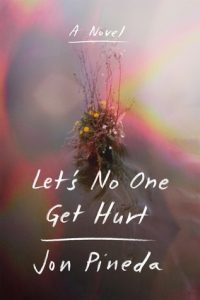Like most readers, I have my habits. In the service of exposing my readers to a wider perspective, I have invited Christina Cox, fellow book lover, to offer her opinions on a recent read. Thank you, Christina!
I first found out about Let’s No One Get Hurt because the author, Jon Pineda, teaches at my alma mater (The University of Mary Washington). I’m a big fan of his poetry, but I’d never read any of his fiction, so I thought I would give it a shot.

Fifteen-year-old Pearl is squatting in an abandoned boathouse with her father, a disgraced college professor, and two other grown men, deep in the swamps of the American South. All four live on the fringe, scavenging what they can–catfish, lumber, scraps for their ailing dog. Despite the isolation, Pearl feels at home with her makeshift family: the three men care for Pearl and teach her what they know of the world.
Mason Boyd, aka “Main Boy,” is from a nearby affluent neighborhood where he and his raucous friends ride around in tricked-out golf carts, shoot their fathers’ shotguns, and aspire to make Internet pranking videos. While Pearl is out scavenging in the woods, she meets Main Boy, who eventually reveals that his father has purchased the property on which Pearl and the others are squatting. With all the power in Main Boy’s hands, a very unbalanced relationship forms between the two kids, culminating in a devastating scene of violence and humiliation.
With the cinematic and terrifying beauty of the American South humming behind each line, Jon Pineda’s Let’s No One Get Hurt is a coming-of-age story set equally between real-world issues of race and socioeconomics, and a magical, Huck Finn-esque universe of community and exploration.
I was about ten pages into the novel when it clicked that this was the best book I’d read all year (what made it even better was that I was reading it by the river, so I really felt like I was right there with the characters). You can tell Pineda’s a poet; every line in the novel is meticulously worded and placed. The novel gets dark– and I mean really dark– in some places, but through it all shines Pearl, who has proved herself to be one of my favorite literary heroines. Consider this great paragraph:
My mother used to say that poems were never finished, that they were only abandoned. I like to take some things my mother said and flip them on their head. For instance, I think all abandoned things are poems. In this way, if this place where we live together is truly abandoned, then we are living inside a poem.
My father says I’m fifteen going on fifty.
I’d absolutely recommend this book. It’s a great size read, especially for the summer. While you’re at it, you can check out Pineda’s poetry as well!